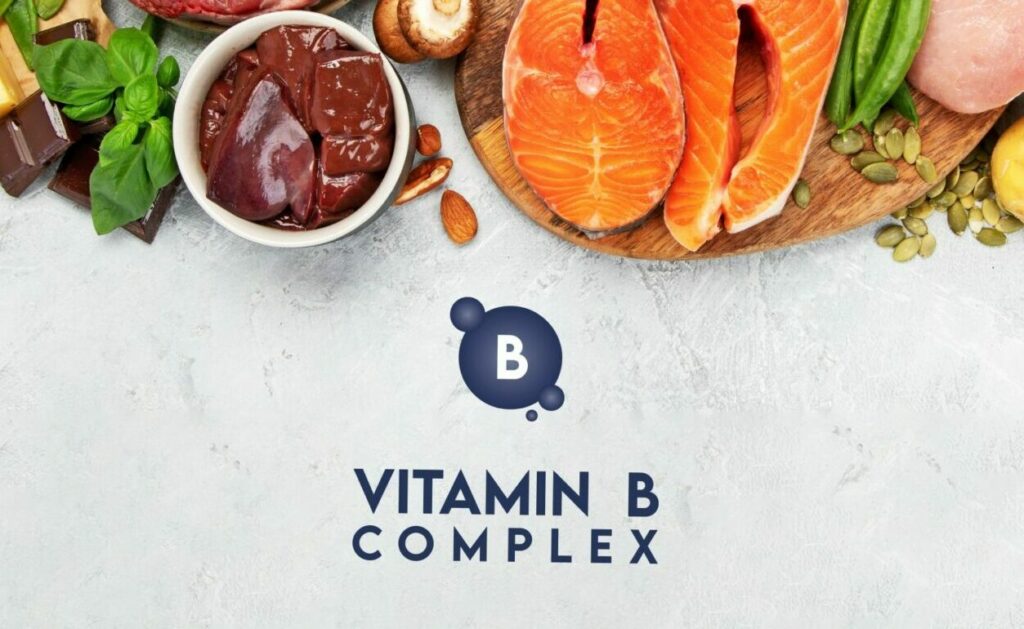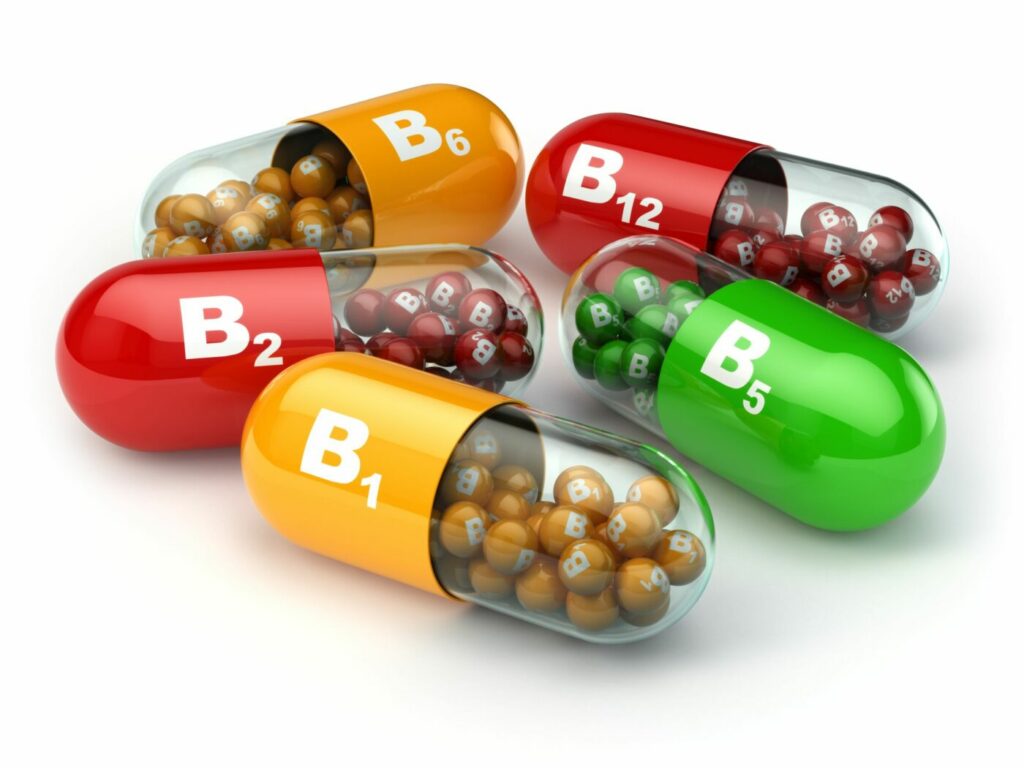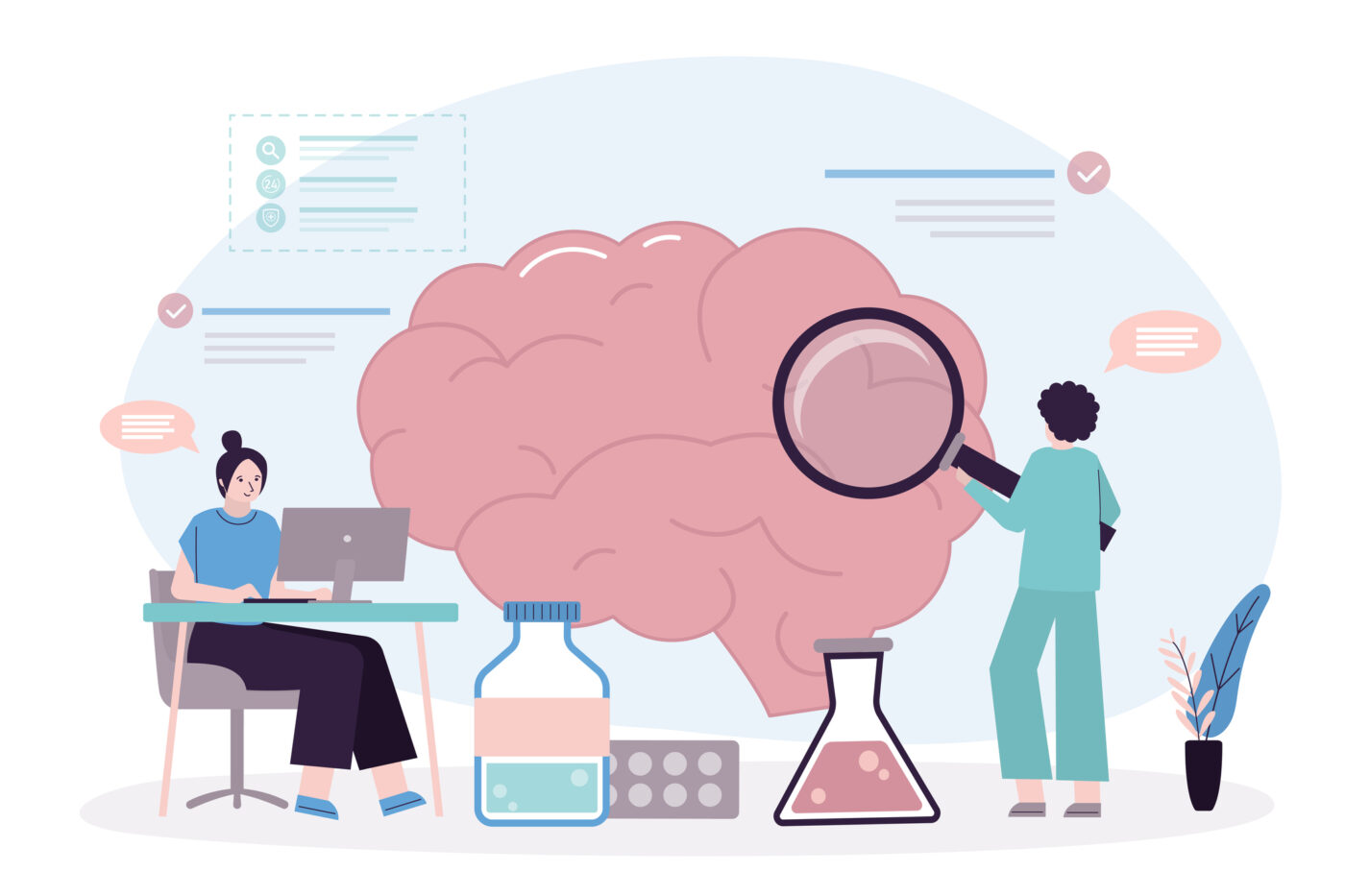B Vitamins – Why do we need them?
Biotin, niacin or folic acid – these are the commonly heard names of substances crucial for our health.

However, not everyone knows that these names represent B vitamins. B vitamins play an essential role in the body and are involved in the functioning of the nervous system, synthesis of hormones, regulation of insulin production, formation of red blood cells and protection of cells against the action of reactive oxygen species and free radicals. That’s why it’s so important to keep your B vitamins at an optimal level to enjoy good health.
Although the B vitamins are presented together, they represent a very diverse group of substances in terms of chemistry and their importance for the body. Their common denominator is solubility in water and the inability to synthesize them by the human body.
Vitamin B1 – thiamine
Vitamin B1 is one of the most important vitamins responsible for the efficient functioning of the nervous system and the metabolism of carbohydrates. Discovered by a Polish scientist, Kazimierz Funk in 1911, who isolated it from rice bran. Funk initiated a group of vitamins defined as “amines needed for life”. He wrongly assumed that only compounds from the group of amines would belong to this group.
Vitamin B1 – occurrence. Where can we find thiamine?
The main sources of vitamin B1 in the diet are: cereal products and dry legumes, yeast, liver, pork, fish and groats. It is important to consume products rich in vitamin B1 regularly because our bodies cannot accumulate it.
Vitamin B1 deficiency – causes and symptoms
Vitamin B deficiency can result in fatigue, impaired concentration and memory, nystagmus, lower mood and depression. In extreme cases, it can lead to the development of the neurological disease Beriberi. Vitamin B1 deficiencies occur mainly in people who abuse alcohol for a long time and take certain medications (e.g. furosemide), which can lead to malabsorption.
Vitamin B1 overdose – symptoms
The overdose of vitamin B1 is difficult to obtain since it is a vitamin that is easily excreted in the urine. However, long-term and excessive supplementation of vitamin B1 can lead to cardiac arrhythmias, dizziness, muscle tremors or an allergic reaction.
Vitamin B2 – riboflavin – characteristics and sources
Riboflavin is involved in oxidation and reduction processes as well as in the functioning of the mucosa, epithelium of blood vessels and skin.
The sources of vitamin B2 in the diet are liver, low-fat cheese, mushrooms, eggs, nuts, dairy products, fish and legumes.
Vitamin B deficiency – symptoms
Typical symptoms of vitamin B2 deficiency are inflammations located in the corners of the mouth. In addition, it can lead to inflammation of the oral cavity, excessive exfoliation of the epidermis and dryness of the conjunctiva. In extreme cases, it can lead to damage to the eyeballs and cornea, growth retardation in children, muscular dystrophy and the development of neurological diseases.
Vitamin B2 overdose – how to recognize?
Vitamin B2 overdose is also difficult to achieve due to limited absorption in the small intestine. However, it is present is manifested by changing the colour of the urine to orange, but this is not a cause for concern.
Vitamin B3 – niacin – characteristic and sources
Niacin, vitamin B3, and vitamin PP are common names for two compounds: nicotinic acid and nicotinamide. These substances play an important role in metabolic processes, and the functioning of the nervous, digestive and skin systems.
The source of niacin in the diet is primarily meat – poultry, veal and giblets. Niacin from plant sources is much less absorbable. With vitamin B3 deficiency, it is important to provide a precursor for the synthesis of niacin, i.e. tryptophan, found primarily in high-protein products (meat, fish, dairy products, soybeans). Bacteria living in our intestines have the ability to synthesize niacin from this compound, which can support supplementation.
Vitamin B3 deficiency – symptoms
Vitamin B3 deficiency can lead to the development of pellagra – a disease manifested by skin inflammation, diarrhoea, abnormal sugar metabolism and mental disorders. Severe niacin deficiency can also lead to the development of depression, limb paralysis, digestive system disorders, dementia and periodontal disease.
Vitamin B3 overdose – symptoms
Like other water-soluble vitamins, excess vitamin B3 is excreted in the urine. However, when it is excessively supplemented, the overdose of vitamin B3 can manifest itself as facial flushing and hot flushes, and in extreme cases, liver damage.

Vitamin B4 – choline – characteristic and sources
Choline plays a great role in the functioning of the nervous system and is involved in the synthesis of lecithin, which supports memory. The appropriate level of choline is especially important in pregnant women because choline supports the development of the foetus, and the development of the nervous system and reduces the risk of birth defects. Choline supplementation is often practised by seniors and students due to the improvement of cognitive processes and memory.
Dietary sources of choline include eggs and meat, wheat germ, legumes, some fish and nuts.
Choline deficiency – symptoms
Choline deficiency is manifested by headaches, concentration problems, and digestive system disorders. In extreme cases, choline deficiency can lead to the development of gastric ulcers, atherosclerosis, and non-alcoholic fatty liver disease, and can lead to serious birth defects in children.
Choline overdose – symptoms
Choline overdose is much less common than its deficiency. If present, it is manifested primarily by an unpleasant odour from the mouth, diarrhoea or vomiting, increased sweating, a drop in blood pressure and increased drowsiness.
Vitamin B5 – pantothenic acid – characteristic and sources
Vitamin B5 is involved in protein-fat metabolism, the synthesis of steroid hormones (cortisol, testosterone) and neurotransmitters (serotonin and dopamine). Vitamin B5 takes part in the regeneration processes of the skin and mucous membranes, therefore it is recommended for people struggling with keratosis and persistent acne. Pantothenic acid affects hair pigmentation, so its supplementation can prevent grey hair.
The source of vitamin B5 in the diet is meat, giblets, fatty fish, eggs, selected fruits and vegetables, legumes, mushrooms, yeast and multigrain products.
Vitamin B5 deficiency – what are the symptoms?
Deficiency of vitamin B5 is manifested by leg cramps, cracking of the corners of the mouth, hair loss, weakness and fatigue, trouble sleeping, irritability and longer healing of wounds.
Vitamin B5 overdose – symptoms
Vitamin B5 overdose is extremely rarely noted. When using excessively high doses, reactions from the digestive system (vomiting, diarrhoea), allergic reactions and cardiac disorders may occur.
Vitamin B6 – pyridoxine – properties and sources
Vitamin B6, called also pyridoxine, represents a group of 6 chemical compounds that are pyridine derivatives: pyridoxine, pyridoxal and pyridoxamine and their 5′-phosphates. Vitamin B6 plays a pivotal role in the activity of over 100 different enzymes, hence its importance in the functioning of the body is huge. Metabolic processes regulated by vitamin B6 include: the metabolism of carbohydrates and amino acids, synthesis of proteins, glycogen and steroid hormones, and production of antibodies and haemoglobin. Vitamin B6 supplements with magnesium ions are a common combination because vitamin B6 can improve the absorption of this element by up to 40%.
The sources of vitamin B6 in the diet are chickpeas, meat, liver, fish, potatoes and other starchy vegetables, bananas, buckwheat and wheat germ.
Vitamin B6 deficiency – symptoms
Vitamin B6 is commonly found in foods, hence its deficiency is relatively rare. If it does occur, it is manifested by anaemia, lowered immunity, skin inflammation, depression, kidney stones, apathy, insomnia and tingling, tremors and numbness of the limbs.
Vitamin B6 overdose – what are the symptoms?
Vitamin B6 overdose may be observed in people who abuse synthetic preparations with pyridoxine with a dose of more than 200 mg per day. It does not occur for pyridoxal phosphate – a biologically active form. Excess of this vitamin has neurotoxic effects and can have serious health consequences, including problems with motor coordination, muscle weakness, degeneration of nervous tissue, amino acid-related disorders and peripheral neuropathy.
Vitamin B7 – biotin – properties and sources
Vitamin B7, biotin, and vitamin H, sometimes also called the beauty vitamin, is a substance that is synthesized by our intestinal bacteria or supplied with food. It improves the condition of hair, skin and nails, hence its great popularity. However, its beneficial effects on the hair occur only in people who are deficient in biotin, and its excess will not affect hair condition. In addition, biotin, along with insulin, stabilizes the level of glucose in the bloodstream, improves our cognitive abilities, and participates in the synthesis of fatty acids and blood coagulation.
Sources of biotin in the diet are liver, egg yolks, nuts, spinach, yeast and multigrain products.
How to recognize vitamin B7 deficiency?
Vitamin B7 deficiency is very rare as this vitamin is synthesized by our microbiome. Deficiency occurs mainly after antibiotic therapy and is manifested by hair loss, skin changes (rashes), elevated cholesterol, lack of appetite and fatigue.
Symptoms of biotin overdose
Excess biotin is excreted in the urine and side effects of its overdose are rarely observed. If they occur, they are manifested by digestive system issues, such as diarrhoea, vomiting or nausea.

Vitamin B8 – inositol – characteristic and sources
Inositol is referred to as a vitaminoid, which is a vitamin-like substance, however, from the historical classification is called vitamin B8. Inositol is not a vitamin according to the new classification, because our body has the ability to synthesize it. Inositol is involved in the metabolism of fats and carbohydrates and plays an important role in the functioning of the nervous and reproductive systems. Often, inositol is used in polycystic ovary syndrome (PCOS) because it reduces hyperinsulinemia and hyperandrogenaemia. Inositol is also used in depressive states because it plays a similar role to antidepressants, increasing the production of substances that transmit signals between nerve cells.
The source of inositol is meat, eggs, liver, yeast, whole grains, vegetables and citrus fruits.
How to recognize inositol deficiency?
Vitamin B8 deficiency is manifested by anxiety, nervousness and nervous system impairment, including mental disorders. In men, long-term inositol deficiency can lead to infertility.
Vitamin B8 deficiency – symptoms
Excess inositol is excreted in the urine and the effects of overdose are rarely observed. They are usually limited to fatigue and gastrointestinal reactions, which subside after discontinuation of the substance.
Vitamin B9 – folic acid – characteristic and sources
Folic acid is responsible for the functioning of the nervous, cardiovascular and hematopoietic systems. It is primarily associated with supplements for expecting mothers because it is of great importance for the development of the foetus. Folic acid deficiency in pregnant women can result in premature birth, low birth weight and serious birth defects, including neural tube defects and spina bifida in the foetus.
The sources of folic acid in the diet are dark green vegetables (kale, spinach, Brussels sprouts, parsley), eggs, liver, ripening cheeses, nuts, and legumes.
Symptoms of deficiency and overdose of vitamin B9
In adults, folic acid deficiency can lead to anaemia, an increased risk of atherosclerosis, depression and psychosis, and inflammation of the digestive tract.
Overdose of folic acid can cause insomnia, irritability, digestive system reactions and depression.
Vitamin B10 – para-aminobenzoic acid (PABA) – characteristic and sources
Para-aminobenzoic acid, called vitamin B10, BX or PABA, is another example of a substance that is not actually a vitamin. It used to be classified as a vitamin, but now it has been removed from this group, as it can be synthesized by our body. Interest in PABA is mainly due to its anti-ageing and pigmentation properties (prevents greying of hair). In addition, PABA is a precursor of folic acid and protects the body against anaemia.
The source of PABA in the diet is primarily meat (beef, pork, veal), as well as eggs, yoghurts, yeast and whole grain products.
Overdose and deficiency of vitamin B10 – symptoms
PABA deficiency is manifested by excessive hair loss, greying, fatigue, low mood and depression.
Overdose of PABA can cause nausea, diarrhoea, rashes and allergic reactions. In rare cases, it can cause serious complications such as liver, kidney and heart damage.
Vitamin B12 – cobalamin- importance and occurrence
Vitamin B12 plays a role in the metabolism of carbohydrates, proteins and fats and the production of red blood cells, affects the skeletal system, helps in learning and supports the neurological system.
The sources of the vitamin are primarily products of animal origin, including liver, beef, veal, eggs and fish. In smaller amounts, cobalamin can be found in milk and milk products, poultry and pork.
Vitamin B12 deficiency – symptoms
The greatest risk of vitamin B12 deficiency is in people who eliminate animal products, i.e. vegans and vegetarians. Symptoms of vitamin B12 deficiency include anaemia, sensory disturbances, dizziness when standing up suddenly, loss of appetite and weight loss, pale yellow skin colour and mood disturbances.
Vitamin B12 overdose – how to recognize?
Vitamin B12 overdose is extremely rare. However, an allergy to vitamin B12 can occur, which is manifested by nosebleeds and in rare cases anaphylactic shock.
Risk groups for B vitamins deficiency
Although there are many products on the market rich in B vitamins, we do not always manage to maintain their optimal level. This is due to the increased consumption of processed food poor in vitamins and rich in simple sugars, fatty acids and additives that improve the taste and smell.
In addition, there are groups of people who should be especially careful about vitamin deficiencies, including:
- Athletes and people who exercise intensively
- Elderly people
- Pregnant women
- People overloaded with prolonged stress or increased physical or mental effort
- Vegetarians and vegans
- People on other elimination diets (gluten-free, lactose-free, ketogenic diet)
- People with digestive and absorption disorders
- People after diseases and surgical interventions
When analyzing the symptoms of vitamin deficiency, it can be noticed that they are not very specific and the same symptoms can indicate different vitamin deficiencies. Therefore, it is important to consult with a physician before starting vitamin therapy, after analyzing the status of individual vitamins in the body. Multivitamins containing the entire B-complex are usually the best solution because many vitamins have a synergistic effect and the risk of taking too much of them is usually low as they are easily excreted in the urine.


